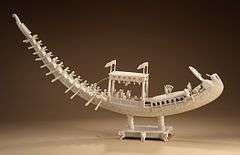Khadga dynasty
Part of a series on the |
|---|
| History of Bengal |
 |
|
Ancient Geopolitical units |
|
Medieval and Early Modern periods |
|
European colonisation
|
|
Calendar |
The Khadga dynasty was a Buddhist power during the Late Vedic period on the Indian Subcontinent, which originated in the region of Bengal. The dynasty ruled the areas of Vanga and later Samatata from the mid 7th to early 8th Century CE.[1] Chronologically, they were the major power in central Bengal between the fall of the Kingdom of Gauda ruled by Shashanka (followed briefly by Manava) and the rise of the Pala Empire established by Gopala. While they did not assume imperial titles, they retained sovereignty over the ancient kingdom of Vanga and later conquered Samatata.
Known kings and reigns
- Khadgodyama (625-640 CE)
- Jatakhadga (640-658 CE)
- Devakhadga (658-673 CE)
- Rajabhat (673-707 CE)
- Balabhat (707-716 CE)
- Udirnakhadga (undetermined reign)
External links
- Khadga Dynasty in Banglapedia
References
- ↑ Sailendra Nath Sen (1 January 1999). Ancient Indian History And Civilization. New Age International. pp. 277–. ISBN 978-81-224-1198-0. Retrieved 18 April 2012.
This article is issued from
Wikipedia.
The text is licensed under Creative Commons - Attribution - Sharealike.
Additional terms may apply for the media files.